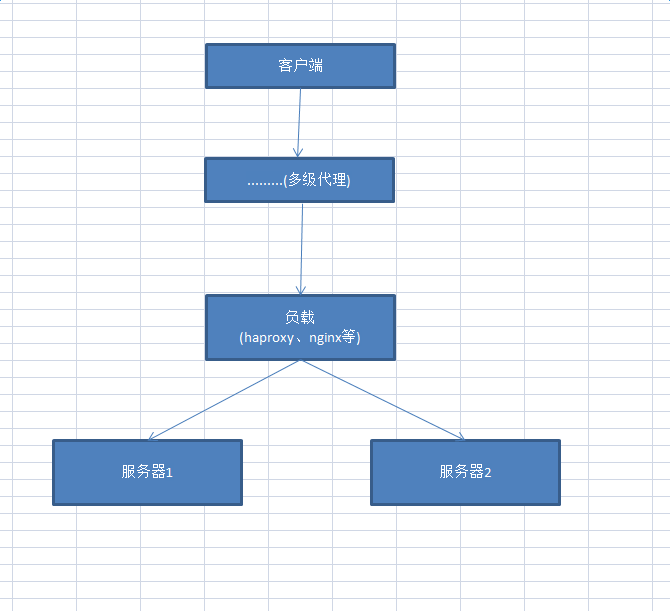Java Web 获取客户端真实IP
转自:https://www.cnblogs.com/xiaoxing/p/6565573.html
发生的场景:服务器端接收客户端请求的时候,一般需要进行签名验证,客户端IP限定等情况,在进行客户端IP限定的时候,需要首先获取该真实的IP。一般分为两种情况:
方式一、客户端未经过代理,直接访问服务器端(nginx,squid,haproxy);

方式二、客户端通过多级代理,最终到达服务器端(nginx,squid,haproxy);

客户端请求信息都包含在HttpServletRequest中,可以通过方法getRemoteAddr()获得该客户端IP。此时如果在使用方式一形式,可以直接获得该客户端真实IP。而如果是方式二中通过代理的形式,此时经过多级反向的代理,通过方法getRemoteAddr()得不到客户端真实IP,可以通过x-forwarded-for获得转发后请求信息。当客户端请求被转发,IP将会追加在其后并以逗号隔开,例如:10.47.103.13,4.2.2.2,10.96.112.230。
请求中的参数:
request.getHeader("x-forwarded-for") : 10.47.103.13,4.2.2.2,10.96.112.230
request.getHeader("X-Real-IP") : 10.47.103.13
request.getRemoteAddr():10.96.112.230
客户端访问经过转发,IP将会追加在其后并以逗号隔开。最终准确的客户端信息为:
- x-forwarded-for 不为空,则为逗号前第一个IP ;
- X-Real-IP不为空,则为该IP ;
- 否则为getRemoteAddr() ;
代码示例:
/**
* 获取用户真实IP地址,不使用request.getRemoteAddr()的原因是有可能用户使用了代理软件方式避免真实IP地址,
* 可是,如果通过了多级反向代理的话,X-Forwarded-For的值并不止一个,而是一串IP值
*
* @return ip
*/
private String getIpAddr(HttpServletRequest request) {
String ip = request.getHeader("x-forwarded-for");
System.out.println("x-forwarded-for ip: " + ip);
if (ip != null && ip.length() != 0 && !"unknown".equalsIgnoreCase(ip)) {
// 多次反向代理后会有多个ip值,第一个ip才是真实ip
if( ip.indexOf(",")!=-1 ){
ip = ip.split(",")[0];
}
}
if (ip == null || ip.length() == 0 || "unknown".equalsIgnoreCase(ip)) {
ip = request.getHeader("Proxy-Client-IP");
System.out.println("Proxy-Client-IP ip: " + ip);
}
if (ip == null || ip.length() == 0 || "unknown".equalsIgnoreCase(ip)) {
ip = request.getHeader("WL-Proxy-Client-IP");
System.out.println("WL-Proxy-Client-IP ip: " + ip);
}
if (ip == null || ip.length() == 0 || "unknown".equalsIgnoreCase(ip)) {
ip = request.getHeader("HTTP_CLIENT_IP");
System.out.println("HTTP_CLIENT_IP ip: " + ip);
}
if (ip == null || ip.length() == 0 || "unknown".equalsIgnoreCase(ip)) {
ip = request.getHeader("HTTP_X_FORWARDED_FOR");
System.out.println("HTTP_X_FORWARDED_FOR ip: " + ip);
}
if (ip == null || ip.length() == 0 || "unknown".equalsIgnoreCase(ip)) {
ip = request.getHeader("X-Real-IP");
System.out.println("X-Real-IP ip: " + ip);
}
if (ip == null || ip.length() == 0 || "unknown".equalsIgnoreCase(ip)) {
ip = request.getRemoteAddr();
System.out.println("getRemoteAddr ip: " + ip);
}
System.out.println("获取客户端ip: " + ip);
return ip;
}
此时,正常情况之下可以获取客户端真实的IP。需要注意的是对于服务器端采用负载的形式,需要配置保存x-forwarded-for。目前负载的形式有haproxy、nginx等形式。结构图如下:

我接触的服务器端配置负载使用haproxy,相对于的配置如下:
frontend crmtest
bind :8081
mode http
option httplog
option forwardfor // 配置HAProxy会把客户端的IP信息发送给服务器,在HTTP请求中添加"X-Forwarded-For"字段。
default_backend drm
backend drm
mode http
option httplog
balance roundrobin
stick-table type ip size 200k expire 30m
stick on src
server jboss1 10.10.10.11:8081
server jboss2 10.10.10.12:8081
haproxy配置参考:http://www.cnblogs.com/dkblog/archive/2012/03/13/2393321.html



